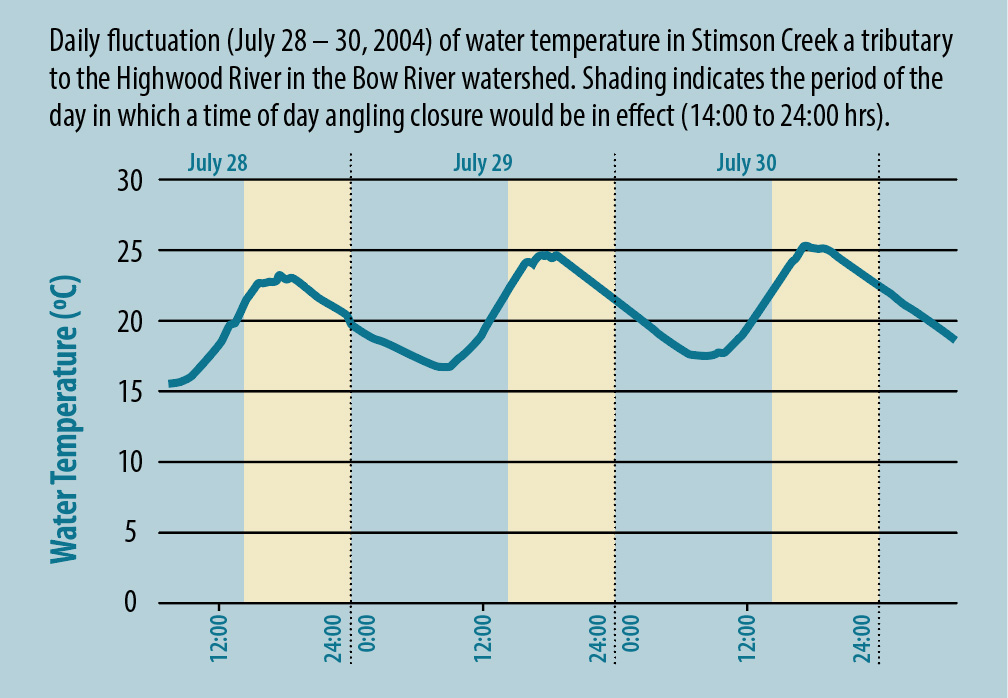
4 minute read
Give A HOOT!
There’s a time to fish and a time not to fish
► by Mike Rodtka
Readers that grew up in the 1970s may remember a cute cartoon owl named Woodsy from the United States Forest Service. Woodsy could be heard encouraging kids to, “Give a hoot! Don’t pollute.” This is still great advice, but may need an update for the new millennia. It’s time to talk about hoot owl angling restrictions.
Time of Day Angling Restrictions
If you like to fish east slopes rivers and streams in southern Alberta, there's a new angling regulation you should be aware of. Alberta fisheries managers now have rules in place to rapidly implement time of day angling restrictions when stream conditions warrant.
The restrictions are designed to protect trout and other coldwater sport fish that are stressed when rivers and streams are unusually low and warm. If water temperature and stream flow thresholds are met, angling is not permitted from 2:00 p.m. to midnight (14:00 to 24:00) in waters covered by the restriction.
Although new to Albertans, time of day restrictions, often referred to as “hoot owl” restrictions, have been around much longer elsewhere in North America. The intent is to protect already stressed trout from the additional stress of being caught and released by anglers when daily water temperatures are at their warmest.
Multiple studies have demonstrated that even the most careful catch-and-release angler inadvertently kills more of their trout catch when water temperatures are relatively high. Most jurisdictions have settled on a threshold water temperature somewhere near the 20°C target set by the Province. A noteworthy aspect of Alberta’s approach is that it considers angler displacement. East slopes streams are naturally cooler in their headwaters than at lower elevations in summer, but it’s often the lower reaches that are most productive and heavily fished.
Basing the geographical extent of hoot owl restrictions on water temperature alone risks simply displacing anglers from warmer low elevation reaches to cooler headwater reaches—which also happen to be prime habitat for native cutthroat and bull trout.
To protect these at-risk species, the Province applies the regulation relatively broadly, helping ensure a restriction implemented downstream does not just shift angling effort to areas where the water may be cooler, but where conservation concerns are even greater.
Introduced in the spring of 2023, anglers did not have long to wait before the new regulation was implemented. Last summer was a scorcher and by the end of July restrictions were in place for essentially all flowing waters in southwestern Alberta. As restrictions are not lifted until conditions reliably improve, they remained in place until mid-August. Government enforcement staff reported that angler compliance with the new regulation overall was good.
This was encouraging because striking the right balance between maintaining angling opportunities and reducing fish mortality can be challenging. What threshold values are appropriate? How and where are thresholds assessed? How big of an area is impacted by the restriction and for how long? These are not simple questions and there is plenty of room for opinions to differ.
Surprisingly little formal evaluation of similar restrictions elsewhere has occurred to date. Thankfully, the one thing everyone does agree on is that our trout fisheries are precious and need to be sustained for future generations to enjoy.
For up-to-date information on Alberta’s time of day angling restrictions, see the latest Alberta Guide to Sportfishing Regulations and the My Wild Alberta Fishing Advisories, Corrections and Closures webpage.

What’s in a name?
On the origin of the nickname “hoot owl” restrictions.
It seems logical that any rule that promotes activity during the dead of night and early morning would be associated with owls, but that’s not where the story ends. Although it’s prudent to view origin stories skeptically, apparently the “hoot owl” term was coined in the western U.S. by the logging industry. It seems they encouraged tree harvest operations during morning hours (when owls hoot) to avoid the higher fire risk during the drier hours of the day. Whatever its origin, the term appears to have stuck with anglers—although most official communications on the subject use the more precise, but much less charming, “time of day” descriptor.










